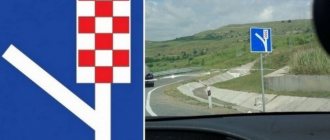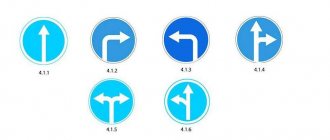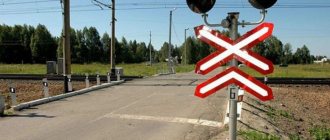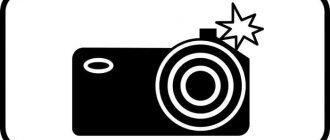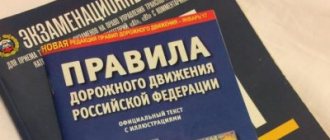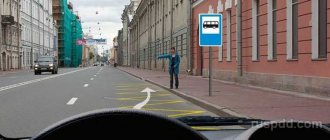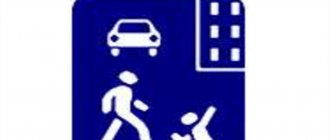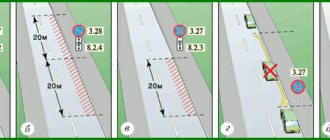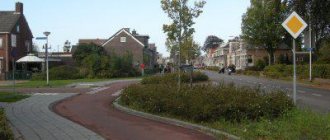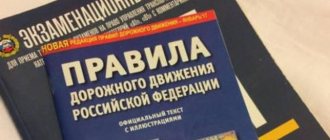Traffic regulations P1 3.2
Prohibiting road sign 3.2 Prohibited traffic prohibits the movement of relevant types of vehicles in both directions.
The prohibition sign does not apply
The effect of the prohibitory sign 3.2 Traffic prohibited does not apply to route vehicles.
The effect of the prohibitory sign 3.2 Traffic is prohibited does not apply to vehicles of federal postal service organizations that have a white diagonal stripe on a blue background on the side surface, and vehicles that serve enterprises located in the designated area, and also serve citizens or belong to citizens living or working in the designated area. In these cases, vehicles must enter and exit the designated area at the intersection closest to their destination.
The effect of the prohibition sign 3.2 Traffic is prohibited does not apply to vehicles driven by disabled people of groups I and II, to vehicles transporting such disabled people or disabled children.
Exceptions
The “No Traffic” sign has exceptions - “more equal than others” in this case will be:
- Russian Post cars with a characteristic identification mark (diagonal white stripe on a blue background);
- route transport;
- cars transporting disabled people ( groups 1 and 2 , no matter in what capacity - driver or passenger);
- cars of citizens permanently residing in this zone or servicing enterprises located in it.
Of course, have documents with you proving that this ban does not apply to you .
For example, invoices, certificates, passport with registration. As for disabled people, we are talking not only about documents confirming their status - that goes without saying.
itself must be equipped with appropriate signs indicating that people with disabilities are driving it.
Keep in mind that the “road guard” will most likely stop the person driving under the limiter. After which he will ask for documents and if they are not available, then a fine will be issued for driving under the “no traffic” sign.
Road sign 3.2 No Entry is not as strict as sign 3.1 No Entry or Brick
Road sign 3.2 No traffic has a white friendly background and a noticeable red border, and in certain cases allows movement under this sign. Obviously, the developers of the sign showed a great sense of humor by strictly calling the sign “No movement” , as if any movement is prohibited and you need to freeze in place when you see the sign, but at the same time, in the traffic rules, they themselves allowed a whole circle of drivers to enter the sign’s coverage area from the nearest intersection.
And, on the contrary, a sign similar in name, which is called only 3.1 Entry is prohibited or Brick, according to the traffic rules, does not allow any movement in its direction to anyone, except for route transport, even disabled people or residents of nearby houses. And, such a violation of traffic rules may result in the deprivation of a driver’s license. Therefore, the background of the sign 3.1 Brick is completely red, it even merges with the red rim of the prohibitory signs. The brick is depicted on the sign in white. Obviously, this is a sand-lime brick, and not an orange one made from baked clay, because the orange color would be less noticeable against a red background.
Now, you better remember what signs 3.1 and 3.2 are called, what they look like, how they differ, which one is stricter, although they are both good.
Sign 3.2 (red circle) prohibits the movement of vehicles in both directions, i.e. it cannot be installed at the entrance to a one-way road.
The traffic prohibited sign does not apply to fixed-route vehicles, as well as to vehicles driven by disabled people of groups 1 and 2 or transporting such disabled people (the identification sign “Disabled” must be installed on the car). Please note that the vehicles listed in this paragraph can move freely on streets marked with sign 3.2.
In addition, sign 3.2 has additional exceptions. For example, its requirements may be violated by vehicles of federal postal service organizations that have a white diagonal stripe on the side surface on a blue background, and vehicles that serve enterprises located in the designated area, and also serve citizens or belong to citizens living or working in the designated area. zone.
However, vehicles listed in this paragraph must enter and exit the designated area only at the intersection closest to their destination.
I would like to draw your attention to the fact that the concept of the nearest intersection is not defined in the traffic rules, but in practice a controversial situation may arise:
Let's take a closer look at this picture. The left intersection is much closer to the intended destination, however, when entering from the right intersection, the driver will have to cover a much shorter distance to the entrance to the yard. It is not clear what to do best in this situation.
I would like to note that if you are going to enter sign 3.2, then it would be better to have some documents confirming your relationship with your destination. For example, a passport with registration at the destination.
The maximum fine for violating the requirements of sign 3.2 is 500 rubles.
What does a white circle with a red border mean?
Before the intersection, in accordance with the traffic rules, prohibiting symbols have designations certifying the purpose of the impact.
The most diverse signal and the 2nd most important prohibition for drivers and traffic police inspectors is “Traffic is prohibited.” Domestic and foreign car owners and legal advisers believe that there are a very large number of signs and exceptions for such a sign.
In educational institutions (driving schools), the meaning and meaning of the symbol is explained in detail - “Entry is prohibited” (“brick”) and “Traffic is prohibited.” The first one prohibits anyone from entering a specific part of the road from the designated area (including disabled people and residents of houses behind a prohibitory sign). The second restricts the passage of vehicles and the movement of pedestrians. Entrance to this section of the road is absolutely free for all categories of citizens.
The road signal “No movement” introduces a categorical prohibition on the movement of vehicles in a specific area. At a theoretical level, this signal does not contain territorial restrictions. The beginning of the prohibition is the space where the signal is installed.
If the prohibition applies to side exits, this is classified by special signs that prohibit movement in the direction indicated by arrows. Because this signal, in accordance with the traffic rules, limits movement in both movement instructions, it is not specified at intersections that have a slope to a one-way street.
Depending on the purpose, it is possible to enter a prohibiting signal:
- Almost on any part of the road or intersection, street, boulevard, driveway, to define a zone for pedestrians.
- On the road and highways where cars drive or on the street for the purpose of temporarily blocking the movement of vehicles (this can be a mass event).
- On roads, city highways, to block traffic in the area where repair work is taking place on the site.
- Before entering a traffic lane that ends in a dead end, or into a yard with one entrance for the purpose of warning (it is installed together with a sign indicating a dead end).
- To the checkpoint and/or entry to the official territory of organizations or enterprises.
The visual signal “No movement”, in accordance with traffic rules, must be indicated by a table with black arrows. They show the specific purpose for which the signal functions, or signs that indicate the types of direction and/or crossing time. In cases where it is necessary to pass under this symbol, but this is impossible to do, then you must go to the end of the restricted zone.
Obstacles may be a post office, a retail store, or an educational institution. If the vehicle is stopped by traffic police inspectors, you must tell the authorized persons about the purpose of the trip. In traffic rules, road movement is the authorized movement of vehicles on specially equipped roads.
The second condition for movement is the crossing of 2 or more intersections. At a theoretical level, a prohibiting signal involves prohibiting transit movement from the first intersection to the next. This means that driving and stopping on this section of the road is not considered a violation.
The number and types of road symbols, taking into account the territorial location of the road, is the responsibility of the division of the road organization serving this section of the roadway. All signs must strictly comply with the installation scheme of road symbols and a specific type in order to avoid trouble. Such road signs are especially important for young and inexperienced drivers.
Movement of motor vehicles is prohibited
The sign for the movement of motor vehicles is prohibited applies exclusively to motor vehicles:
Let me remind you of the definition of a motor vehicle from paragraph 1.2 of the traffic rules:
“Motor driven vehicle” is a vehicle driven by an engine. The term also applies to any tractors and self-propelled machines.
However, the sign does not apply to vehicles that are not covered by the previous sign 3.2, namely, cars for disabled people, public transport, postal vehicles, as well as vehicles serving citizens and enterprises located in the designated area. In general, all requirements are similar to the previous paragraph.
Truck traffic prohibited sign
The sign for the movement of trucks is prohibited applies to trucks and combinations of vehicles whose permissible maximum weight exceeds 3.5 tons, if the weight is not indicated on the sign, or the weight indicated on the sign (in this example - 8 tons):
This sign also prohibits the movement of tractors and self-propelled vehicles, but does not prohibit the movement of trucks designed to transport people.
This sign does not apply to postal vehicles, as well as trucks without a trailer with a permissible maximum weight of not more than 26 tons, serving enterprises located in the designated area. Let me remind you that these trucks can only enter from the intersection closest to their destination.
Mounting methods
The method of attaching the sign to a heavy truck will depend on the material from which it is made.
There are two types of signs:
- self-adhesive vinyl film;
- galvanized steel with anti-corrosion treatment.
Self-adhesive signs are easy to place on the cab or body of the car. To do this, you should thoroughly clean and degrease the surface, remove the protective film from the plate, then stick it on, carefully smoothing out any wrinkles with a dry cloth. If necessary, such a sticker can be easily removed. It does not spoil the paintwork of the car, it is not afraid of weather disasters, and has a reflective effect.
We suggest you familiarize yourself with the process of gluing a vinyl sticker on a car (the technique does not change for a truck):
Metal plates may have special hooks provided by the manufacturer, or they may be mounted with self-tapping screws.
For your information! Previously, symbols on the body, applied using airbrushing, were very popular. Now they are increasingly being replaced by vinyl film.
Motorcycles prohibited sign
The road sign prohibiting the movement of motorcycles applies exclusively to motorcycles and prohibits their movement on the road in both directions:
This sign does not apply to postal motorcycles that have a white diagonal stripe on a blue background, as well as to motorcycles serving enterprises and citizens located in the designated area.
Please note that if you have this sign, you can drive your personal motorcycle to your home. Also, for example, a pizza delivery man will be able to come to you. As for postal motorcycles that have blue sides with a diagonal white stripe, I have not seen such vehicles.
Let me remind you that entry under the motorcycle prohibited sign is also only possible from the intersection closest to your destination. The penalty for violating the requirements of this sign is a warning or a fine of 500 rubles.
In the next series of “Traffic Signs”, the article will look at the next prohibitory road signs.
A red circle on a white background is a sign that is often confused by drivers, especially beginners. They confuse it with a “brick”, although the difference is quite significant - the circle is simply surrounded by a red frame, there are no symbols inside. Let's figure out what the road sign means - a white circle with a red rim.
According to traffic rules
In the rules, the sign with a red ring is designated by the numbers 3.2 and belongs to the category of prohibitory signs. It means that movement by vehicles is strictly prohibited on the further section of the road. Moreover, the ban applies in both directions.
Coverage area
A pillar with a white background, surrounded by a red circle, has its own coverage areas:
- at the entrances to the prohibited territory;
- in places where repair work is carried out;
- in front of pedestrian traffic areas;
- in front of adjacent areas where there is a dead end.
Are there exceptions?
Like many road signs, this one with a red border has its exceptions to the basic rules. They can ignore it:
- Russian Post vehicles with special designations;
- route vehicles;
- transport driven by disabled people of groups 1 and 2;
- vehicles whose owners live in the area where the sign is valid;
- transport of service organizations located in this territory.
Punishment for violation
A white sign with a red border is considered prohibitive. You shouldn’t ignore it, although many drivers don’t even pay attention. The fine for violating and driving under the sign is not that high, only 1,500 rubles. Authorities believe that this offense is not so serious, because by violating the driver does not pose a threat to other traffic participants, since there should be no other vehicles in this area under sign 3.2.
How traffic police officers prove a violation
In most cases, violations are recorded personally by traffic police inspectors.
Near the “No Traffic” zone, which has a red edge, there is often a patrol station that stops drivers who have violated traffic rules. If the driver of the car has documents with him that give priority and permission to travel, then he is calmly released to continue driving. If the driver does not have the right to drive under the sign, then he is issued a protocol. If the driver believes that the protocol was issued in violation of the laws, then he can try to challenge the decision to fine the traffic police. But in practice this is almost impossible to do. But if the driver has the necessary documents for travel, but is still given a fine, then it’s worth fighting for your rights. For example, if, having stopped a forwarder of a retail outlet who has documents, he was still given a fine.
In the protocol, do not rush to sign everything that the inspectors indicated. Please read the document carefully. If you don't agree, write it there. In general, if you are faced with unlawful actions, try to do everything so that later you have a solid evidence base that will be taken into account in court.
What punishment is provided by law?
Quite often, drivers do not pay attention to this sign and break the rules when entering. It should be noted that such a violation entails administrative liability in the form of a fine. In 2021, the penalty for driving under this sign is only 500 rubles. And sometimes the inspector even issues a verbal warning to the driver.
In this case, the degree of severity will depend on the arguments of the offender. If a violator is stopped more than once for driving under a prohibitory sign, then he will have to fork out and pay the amount written out by the inspector as a punishment.

